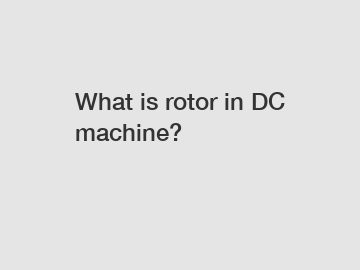What is rotor in DC machine?
What is Rotor in DC Machine?
The rotor is a crucial component of a DC machine that plays a significant role in its operation. It is responsible for converting electrical energy into mechanical energy and is an essential part of the overall system. In this article, we will delve into the details of the rotor, its origins, the process of its functioning, as well as its significance and impact.
The term "rotor" refers to the rotating component of a DC machine, such as a DC motor or generator. It is typically composed of a shaft, windings, and a commutator. The shaft provides the mechanical support for the rotor, allowing it to rotate. The windings consist of insulated wire coils that are wound around the shaft. These windings are connected to the commutator, which facilitates the flow of current in the rotor windings.

The origins of the rotor can be traced back to the early developments in electrical machines. The concept of a rotating component was first introduced by Michael Faraday in the early 19th century. Faraday's experiments with electromagnetic induction led to the discovery of the fundamental principles behind the operation of DC machines. His work laid the foundation for the development of the rotor as a key element in electrical machines.
The functioning of the rotor in a DC machine is based on the principle of electromagnetic induction. When an electrical current is passed through the rotor windings, a magnetic field is created around the windings. This magnetic field interacts with the magnetic field produced by the stator (the stationary component of the machine), resulting in the rotation of the rotor. As the rotor rotates, it generates mechanical energy that can be harnessed for various applications, such as driving machinery or generating electricity.
The significance of the rotor in DC machines cannot be overstated. It is the component responsible for the conversion of electrical energy into mechanical energy, enabling the machine to perform useful work. Without a properly functioning rotor, the DC machine would be rendered useless. Additionally, the design and construction of the rotor have a direct impact on the performance and efficiency of the machine. Factors such as the type of winding, the quality of the shaft, and the design of the commutator all contribute to the overall performance of the rotor.
In conclusion, the rotor is a critical component in a DC machine that enables the conversion of electrical energy into mechanical energy. Its origins can be traced back to the pioneering work of Michael Faraday, and its functioning is based on the principle of electromagnetic induction. The design and construction of the rotor directly impact the performance and efficiency of the machine. Understanding the role of the rotor in DC machines is essential for anyone seeking to delve into the world of electrical machines and their applications.
If you are looking for more details, kindly visit custom stamped stator and rotor cores, stator and rotor manufacturer, stator lamination welding.


